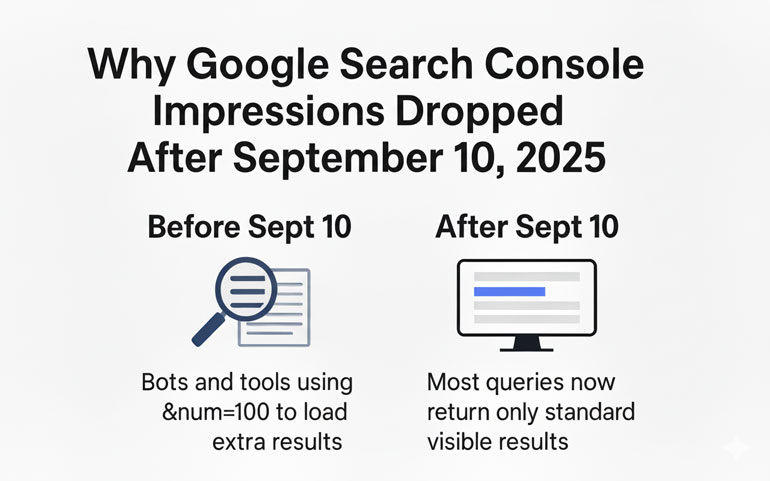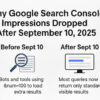Around mid-September, we saw a sharp decline in impressions across many of our clients’ Google Search Console reports. Some sites dropped 30 to 50 percent, especially on desktop. At the same time, clicks stayed consistent and average position jumped for a lot of keywords. That combination told us right away this was not a ranking loss. It was a reporting shift.
Once we dug into it, we found the cause.
What Actually Changed
Between September 9 and 14, Google disabled the &num=100 parameter. That parameter was used by SEO tools, bots, and scrapers to load up to 100 search results in a single query. It was never meant for public use, but rank trackers and data platforms relied on it to scan deeper results quickly.
Now that the parameter no longer works the way it used to, automated systems cannot pull large batches of results in one go. In many cases, trying to force &num=100 now only returns the standard first page of results. That means impressions from deeper ranking positions are no longer being counted the way they were before.
Those impressions were not coming from real users. They were coming from automated tools loading pages and triggering inflated counts in Search Console.
Why Clicks Did Not Drop
Clicks reflect human behavior. Since real users rarely make it past the first page of search results, the removal of automated scraping did not affect traffic. That is why clicks stayed level even when impressions dropped.
Average position often improved too. That is because the old data was averaged across deep-position impressions that were never seen by a person. Once those disappeared, the average shifted toward the rankings that actually matter.
Why Google Likely Made This Move
Google has not made a formal announcement, but the reasons are clear enough when you look at the timing and industry response. Removing the &num=100 shortcut makes it harder for:
-
Rank tracking tools to pull bulk SERP data
-
AI companies to harvest training data from live search results
-
Competitors to scrape SERP layouts and ranking signals
-
Third-party services to resell SERP data at scale
A job posting that appeared briefly after the change referenced anti-scraping work, traffic pattern analysis, and machine learning to detect and block abusive requests. That aligns with Google tightening access to its search engine results.
What This Means for Your Reports
If your impressions dropped but your clicks held steady, your visibility did not decline. The inflated impressions tied to scraping activity simply disappeared.
Here are the common patterns we saw:
-
Desktop impressions dropped more than mobile
-
Sites with rankings beyond the top 10 saw the biggest declines
-
Average position improved for many keywords
-
Clicks and traffic stayed normal
This is not a penalty and not an algorithm hit. It is a correction in how visibility is measured.
What to Pay Attention To Now
Impressions were always a directional metric. They gave a sense of exposure but did not tie directly to performance. Now that the inflated portion is gone, you should focus more heavily on the numbers that translate to results.
The metrics that matter most now are:
-
Organic clicks
-
Conversions and goal completions
-
Revenue tied to organic traffic
-
Page-one rankings
-
Landing page engagement
If impressions fell but traffic did not, your visibility is stable. If both declined, that is when it is worth reviewing rankings, content quality, and keyword targeting.
Why This Change Is Not a Bad Thing
For years, impressions included automated data from requests that were never tied to human users. Ranking in position 75 might have shown impressions in Search Console, but that did not mean anyone saw your listing.
Now your impression numbers more closely reflect real user visibility. Cleaner data means better analysis and fewer false signals.
Are Scrapers Gone Completely?
Not entirely. Some third-party APIs have already attempted workarounds, and a few claim to still retrieve 100 results through alternate methods. How long those will last is uncertain. Google is actively cracking down on automated access and has already limited other SERP features, like infinite scroll.
The overall shift suggests Google is closing the door on broad SERP scraping. That impacts SEO tools, AI training, and data services more than website owners.
What We Are Doing for Clients
We have already adjusted how we interpret post-September data. We do not compare impressions before and after the change without context, and we make sure clients understand this is a reporting correction, not a visibility loss.
Here is how we are handling it:
-
Explaining the source of the impression drop before assumptions take hold
-
Tracking trends based on clicks and conversions instead of raw impressions
-
Watching page-one keyword movement instead of deep ranking noise
-
Prioritizing content that pushes into visible positions
-
Keeping stakeholders informed so there is no confusion
The Takeaway
If your impressions dropped after September 10 but your clicks stayed steady, nothing meaningful changed in your rankings or visibility. Google removed inflated impression data caused by automated scraping, and your reporting is now cleaner and closer to real user behavior.
This is not something to fix. It is something to understand.
If you want help reviewing your reports, explaining this to your leadership team, or adjusting your tracking strategy going forward, we can walk you through it. We have already adapted our reporting and performance reviews to reflect the new baseline and will continue watching the trends that actually drive business growth.





